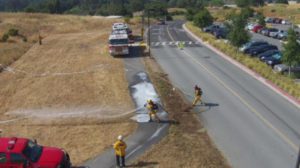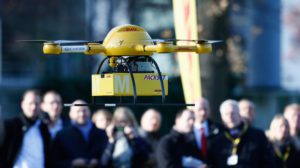If you are one of many who may be interested in operating a drone for your company or a particular task, you should realize that it requires more skill than you may think. While simple, beginner-level drones for play may be easy to operate right out of the box, commercial drones are anything but simple. This is where the vital importance of drone training programs come into focus.
More than simple operating skills, a commonly overlooked aspect of drone flight operations is training for your particular goals and needs. How you intend to use the drone will dictate some specific training. Plus, there are legal considerations, safety protocols, an FAA part 107 exam to be passed, drone best practices, and gaining a full understanding of the capabilities of the particular machine you intend to operate.
What Should Be Included in Professional Drone Training Programs?
Your professional drone training should always include the basics of legal concerns, FAA regulations, safety considerations, and basic operating skills. However, it should also be tailored to fit the specific needs of your intended use. Here are some brief descriptions of common elements that should be a part of any professional drone training program.
Understanding FAA Part 107 Regulations
Regardless of whether you plan to operate a drone for personal or commercial use, you must obtain a Remote Pilot Certificate under the Small UAS Rule (Part 107) of the Federal Aviation Administration (FAA). This certification covers all the related regulations, basic operating requirements, safety protocols, and other important considerations for flying a drone.
To meet the eligibility requirements for obtaining your FAA license, you must:
- Be at least 16 years old
- Be able to read, speak, write, and understand English
- Be in a physical and mental condition to safely fly a drone
- Pass the initial aeronautical knowledge exam
Building Standard Operating Procedures
Most large companies look to expert consultants to help them with building operational drone programs and integrating into their business workflows, marketing, IT, security, and other operational aspects of their business. At 1UP, we believe there are 4 key steps to beginning this journey. They are as follows:
Step 1: Do a risk assessment – take an honest look at the operating picture with no wrong answers. We encourage you to use an “INSPIRATION WHITEBOARD”. Begin to ask and answer questions such as
- Could drones be valuable in our operations?
- What “problems” are we solving?
- Employee safety
- Time value
- Planning
- Asset management
- What data are we collecting?
- Who should be collecting?
- Where will it be used?
- How will/could drones be used?
- Who will have access to them…and the data?
Step 2: Identify stakeholders (examples)
- IT
- IT Security
- Chief Pilot (Crewed Aviation Program)
- Software Vendors
- GIS Director
- Line of business (users of the data)
Step 3: Classify the Operations and Data To Be Collected
- Sensitivity of the Operations
- Protection of the Data
- Data handling
- Public
- Internal
- Confidential
- Restricted
Step 4: Watch out for Adversaries – understand your data requirements
- Activists
- Curious teenagers
- Ex-Employee’s
- Competing Company
- Nation State
Capabilities of Drone Components
Drone training programs should seek to cover the basics of the particular drone you plan to operate, including learning about and exercising its capabilities. There are also many popular applications and accessories that provide for expanded drone uses. Downloadable apps are also available that can further expand a drone’s capabilities, including tracking, mapping, navigation, flight performance and more.
Proper Operating Procedures
Drone training should always cover the basics of the science of flight and advanced drone flight, including many maneuvers considered critical in commercial applications, like hovering and smooth flight movements. Certain basic protocols for care and operation should be covered, including proper etiquette when flying a drone and legal restrictions in various areas.
Professional drone training programs should provide specific instruction that applies to your particular industry or business. For example, if your company plans to use aerial drones in real estate, surveying or mapping, or even search-and-rescue, pilots should be shown particular flight operations and skills that are applicable, as well as related upgrades or technologies for that industry.
Pre-Flight Planning
Planning your flight operations is a critical aspect of operating a drone for commercial uses. Pre-flight planning allows you to map out your operations and take full advantage of available battery life, weather conditions, necessary task elements, and more. It should also involve learning more about your operating area and any restricted airspace that could impede your operations.
Safety
Every professional drone training program should cover the basics of safety, including setup, planning, operations, and recovery. Certain laws and regulations apply to safe drone operations, and some local restrictions may also apply. Safety should always be of paramount importance in any drone flight operations.
Emergency Recovery Procedures
Many things can happen in drone operations that require emergency measures. Sudden wind gusts, electrical shortings, depleted batteries, and more can cause your expensive drone to act erratically or crash suddenly. Long-distance drone operations could even see your drone lost, requiring hours to locate and recover. Drone training experts can demonstrate certain emergency recovery procedures that can help you handle the unexpected.
Weather
Outdoor drone operations must take weather into consideration. In fact, your pre-flight planning should always include a weather plan and emergency plan, in case unexpected and/or severe weather conditions develop. Learning about your particular drone’s flight capabilities is also vital to planning for its use in different types of weather.
Video and Photography Basics
Most commercial drone applications will use video and/or photography capabilities, so some basic instruction in these operations is always a welcome addition to drone training. Using a drone for photos and videos is quite different from holding a still camera on the ground. Certain flight maneuvers will also apply, so combining this with photography and video is a valuable aspect of drone training.
Hands-On Instruction and “Stick Time”
Professional drone training programs must include hands-on instruction for your particular drone and actual time flying it, or “stick time.” Nothing can compare to actually operating your drone. Classroom instruction is valuable, and learning the basics is a must; but all that only prepares you for flying the drone and using it for your specific commercial application.
1UP Drones Professional Drone Training
1UP Drones offers three levels of professional drone training to meet the needs of both personal and commercial users. Get the training you need to carry out any commercial applications with your particular type or model of drone from industry professionals with loads of experience and expertise. Contact 1UP Drones today for more information and scheduling.


